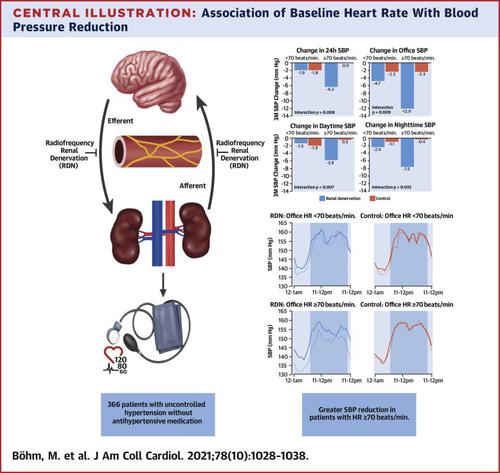Journal of the American College of Cardiology ( IF 24.0 ) Pub Date : 2021-08-30 , DOI: 10.1016/j.jacc.2021.06.044 Michael Böhm 1 , Konstantinos Tsioufis 2 , David E Kandzari 3 , Kazuomi Kario 4 , Michael A Weber 5 , Roland E Schmieder 6 , Raymond R Townsend 7 , Saarraaken Kulenthiran 1 , Christian Ukena 1 , Stuart Pocock 8 , Sebastian Ewen 1 , Joachim Weil 9 , Martin Fahy 10 , Felix Mahfoud 1

|
Background
Sham-controlled trials demonstrated safety and efficacy of renal denervation (RDN) to lower blood pressure (BP). Association of baseline heart rate with BP reduction after RDN is incompletely understood.
Objectives
The purpose of this analysis was to evaluate the impact of baseline heart rate on BP reduction without antihypertensive medications in the SPYRAL HTN-OFF MED (Global Clinical Study of Renal Denervation With the Symplicity Spyral Multi-electrode Renal Denervation System in Patients With Uncontrolled Hypertension in the Absence of Antihypertensive Medications) Pivotal trial.
Methods
Patients removed from any antihypertensive medications were enrolled with office systolic blood pressure (SBP) ≥150 and <180 mm Hg and randomized 1:1 to RDN or sham control. Patients were separated according to baseline office heart rate <70 or ≥70 beats/min. BP changes from baseline to 3 months between treatment arms were adjusted for baseline SBP using analysis of covariance.
Results
Scatter plots of 3-month changes in 24-hour and office SBP illustrate a wide range of changes in SBP for different baseline heart rates. Treatment difference at 3 months between RDN and sham control with baseline office heart rate ≥70 beats/min for 24-hour SBP was −6.2 mm Hg (95% CI: −9.0 to −3.5 mm Hg) (P < 0.001) and for baseline office heart rate <70 beats/min it was −0.1 mm Hg (−3.8 to 3.6 mm Hg) (P = 0.97) with an interaction P value of 0.008. Results were similar for changes in office, daytime, and nighttime SBP at 3 months, with a greater reduction in SBP with baseline office heart rate ≥70 beats/min.
Conclusions
Reduction in mean office, 24-hour, daytime, and nighttime SBP for RDN at 3 months was greater with baseline office heart rate ≥70 than <70 beats/min, suggesting an association between baseline heart rate and BP reduction after RDN. (SPYRAL PIVOTAL—SPYRAL HTN-OFF MED Study; NCT02439749)
中文翻译:

心率对未控制的高血压患者去肾神经结果的影响
背景
假手术对照试验证明了去肾神经支配 (RDN) 降低血压 (BP) 的安全性和有效性。尚未完全了解 RDN 后基线心率与血压降低之间的关系。
目标
本分析的目的是在 SPYRAL HTN-OFF MED(使用 Symplicity Spyral 多电极去肾神经系统治疗未控制的高血压患者的肾去神经支配的全球临床研究)中评估基线心率对血压降低的影响。没有抗高血压药物)关键试验。
方法
停用任何抗高血压药物的患者纳入诊室收缩压 (SBP) ≥150 和 <180 mmHg,并按 1:1 随机分配至 RDN 或假对照。根据基线诊室心率<70 或≥70 次/分钟将患者分开。使用协方差分析针对基线 SBP 调整治疗组之间从基线到 3 个月的血压变化。
结果
24 小时和诊室 SBP 3 个月变化的散点图说明了不同基线心率的 SBP 变化范围很广。3 个月时,24 小时 SBP 基线诊室心率≥70 次/分钟的 RDN 和假对照之间的治疗差异为 -6.2 毫米汞柱(95% CI:-9.0 至 -3.5 毫米汞柱)(P < 0.001)基线诊室心率 <70 次/分钟,为 -0.1 毫米汞柱(-3.8 至 3.6 毫米汞柱)(P = 0.97),交互作用P值为 0.008。3 个月时诊室、白天和夜间 SBP 的变化结果相似,基线诊室心率≥70 次/分钟时 SBP 降低幅度更大。
结论
3 个月时 RDN 的平均诊室、24 小时、白天和夜间 SBP 的降低在基线诊室心率≥70 时大于 <70 次/分钟,表明基线心率与 RDN 后血压降低之间存在关联。(SPYRAL PIVOTAL—SPYRAL HTN-OFF MED 研究;NCT02439749)


























 京公网安备 11010802027423号
京公网安备 11010802027423号